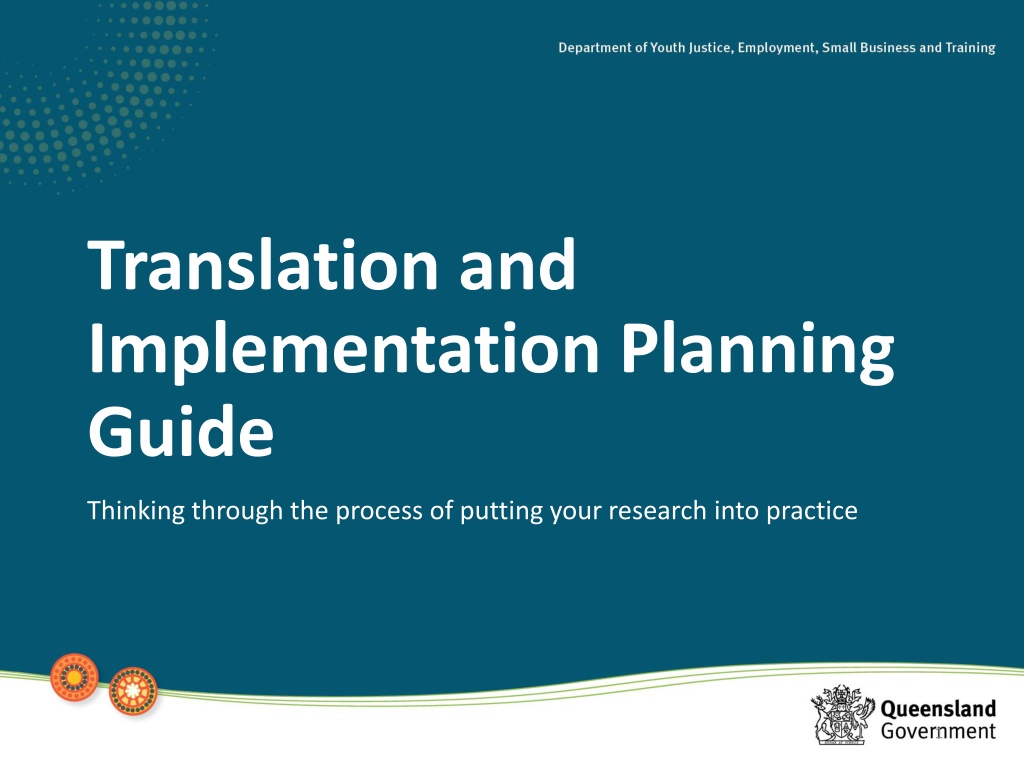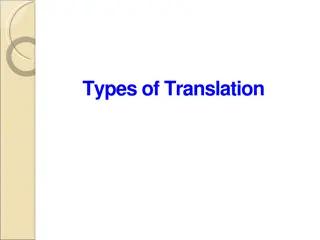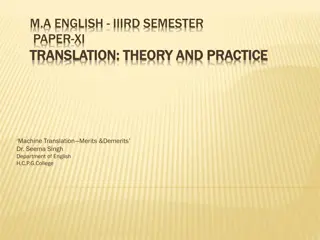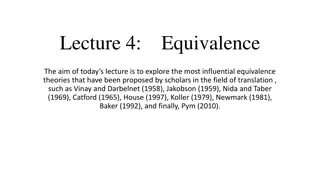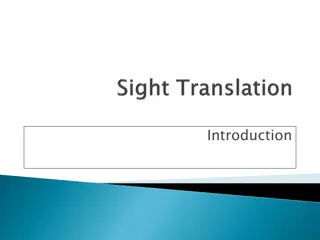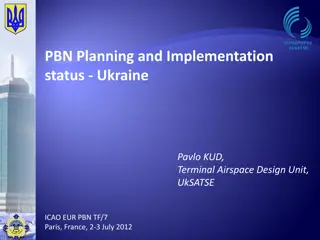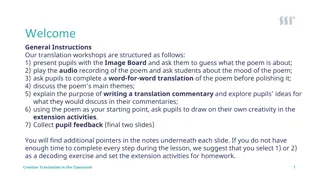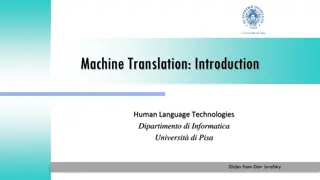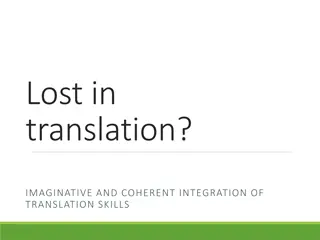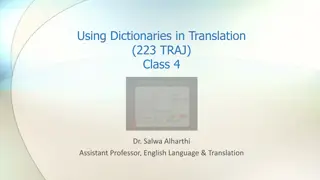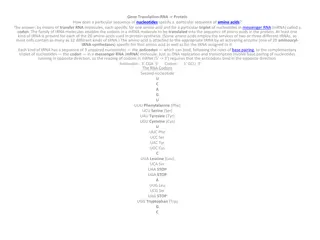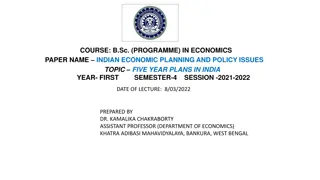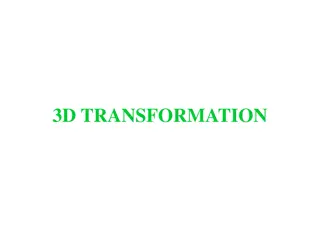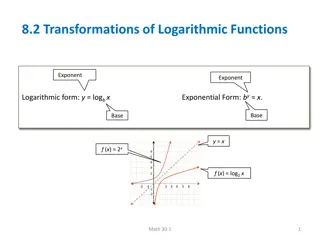Guide to Translation and Implementation Planning
This guide is designed for researchers and project staff to effectively plan for the translation and implementation of research findings into practical outcomes. It covers key aspects such as communicating research, engaging decision-makers, involving stakeholders, and monitoring impact. Through detailed planning and workshops, the aim is to ensure research outcomes are effectively utilized and disseminated to various audiences beyond end-users.
- Translation planning
- Implementation strategies
- Research communication
- Stakeholder engagement
- Impact monitoring
Download Presentation

Please find below an Image/Link to download the presentation.
The content on the website is provided AS IS for your information and personal use only. It may not be sold, licensed, or shared on other websites without obtaining consent from the author. Download presentation by click this link. If you encounter any issues during the download, it is possible that the publisher has removed the file from their server.
E N D
Presentation Transcript
Translation and Implementation Planning Guide Thinking through the process of putting your research into practice 1
Contents Page Who is this Guide for and what does it aim to achieve? 3 What does translation and implementation planning involve? 4 How to use this guide 5 Translation and Implementation Discussion Topics and Questions Expected translation and impact 6 End-users and audiences 7 & 8 Barriers and enablers 9 & 10 Communicators and presenters 11 & 12 Timing for translation activities 13 Evidence References 14 & 15 2
Who is this Guide for and what does it aim to achieve? Researchers and YJ staff who are the sponsors, leads outcome owners and end users of research projectscan use this guide to support planning for: https://static.thenounproject.com/png/542483-200.png Translation and Implementation Plans can be detailed and updated over the life of the project in the template provided and also recorded at a high-level in the Research Application Form. Projects with a high level of investment and significant expected impacts require more detailed translation and implementation planning which will be informed by a facilitated Translation and Implementation Planning Workshop. https://static.thenounproject.com/png/907075-200.png Translation and implementation planning aims to support researchers and YJ staff to ensure that: Research findings are translated into products that meet decision-makers needs and preferences and assist decision-makers to implement research findings. Research-informed products are used by decision-makers to inform strategy policy, programs and practice by end-users. Impact arising from the translated and implemented research can be monitored and evaluated. YJ researchfindings and impact are disseminated and communicated to audiences other than direct end- users such as the general community, other government and non-government social services providers, academic community, and/or specific sectors within those broad groups etc. 3
What does translation and implementation planning involve? Fundamentally, translation and implementation planning involves systematically thinking through: How research findings need to be communicated and presented so that they are relevant, timely, accessible and engaging for the decision-makers expected to take up those findings How research findings could be used to inform policy, program or practice development, implementation and/or evaluation or current thinking and understanding of an issue Who are the people that need to be involved and/or accountable within this process How and when you will communicate and engage with the people you identify would need to be involved or engaged. On the following page we detail some of the key questions that are important to address when planning for translation and implementation, in relation to each of the key components of translation, outlined below: Expected translation and impact End-users and audiences Communicators and presenters Barriers and enablers Format and channels Timing for translation activities. 4
How to use this Guide The required level of investment in translation and implementation planning is determined by the YJ Research team as part of the research project review and approval process. The YJ Research team also undertake a Stakeholder Mapping exercise as part of the research project approval process. The identified stakeholders should be involved in translation and implementation planning wherever possible. The YJ Research team can share the stakeholder mapping outcome with you. The YJ Research Team will determine whether: This Guide can be used to complete the Translation and Implementation Plan, or The project requires a Translation and Implementation Planning Workshop to be held prior to completing the Translation and Implementation Plan. For projects requiring a Translation and Implementation Planning Workshop: This will be organised and facilitated by the YJ Research team. You can use this guide to familiarise yourself with key considerations of translation and implementation planning prior to the workshop, in completing the Plan following the workshop, and throughout the project lifecycle. For projects where this Guide can be used to complete the Translation and Implementation Plan: The YJ Research team can facilitate this process in partnership with you, or you can complete this yourself and send to the YJ Research team for advice and support. Translation and Implementation Plans must be provided to the YJ Research team once completed. To use this Guide to inform translation and implementation planning you should: a) Ask yourself/the team the questions set out in the following topic sections b) Record your answers in the Table in the template and outline next steps c) You can also then use this to produce the Translation and Implementation Plan if you see that your translation and impact measurement activities are numerous and/or will be conducted over lengthy time periods and would benefit from project management 5
Expected translation and impact What is the research-informed change/innovation/intervention/information that we want to share, disseminate, see implemented? Translation Planning How might/could this be implemented in policy, practice, programs? What is the expected implementation process who needs to be involved? What benefits is this change/innovation/intervention/information likely/expected to bring? How would you know that change/innovation/intervention/information had been used or considered or implemented and/or sustained? Who would you have to ask to determine or confirm/attest to this? What kind of measures would help you monitor this? Do they already exist or would you need to develop/implement them? How could you determine if the implementation of the change/innovation/intervention/information had the expected outcomes and benefits? What KPIs of the end-user/implementer organisation/environment and/or funder will the excepted outcomes and benefits impact? How can you find out about KPIs if you re not sure? Impact Assessment 6
End-users and audiences End Users/Key stakeholders Who would implement the change/innovation/intervention/information? Describe in as much detail as possible help see or visualise what is being delivered Who would need to approve/authorise and/or allow/provide budget for implementation of the change/innovation/intervention/information? Who would implementation of the change/innovation/intervention/information affect? Who would need to do something new or differently? Who would be impacted/benefited by implementation of the change/innovation/intervention/information? Who s outcomes are we seeking to improve? Audiences Who would be interested to know about the change/innovation/intervention/information and potential and achieved benefits/outcomes? Who could spread or share communications about the change/innovation /intervention/information? 7
End-users and audiences End Users Audiences All of YJ Specific teams within YJ Specific roles within YJ YJ clients: children, families, women, youth etc. Service providers: support services, counsellors etc. Peak bodies/related organisations Advocacy/awareness raising groups and campaigns NGOs Other government departments/federal government departments/ 8
Factors that could affect translation Question Response Considerations, assumptions and gaps in knowledge Record barriers and facilitators related to implementation of the change/ innovation/ intervention/ information How could we maximise positive and minimise negative factors 9
Key factors affecting use of academic research evidence Individual Organisational External Relevance (perceived vs actual) To their work, issues, KPIs Agenda , issues and interest Communication and Credibility of the source (researcher and research) Communication Face to face Shorter faster simpler docs Tools, processes & strategies Actionable recommendations Stakeholder feedback and action Stakeholder push or block Media involvement Skills for research use Ability to assess and apply research Ability to influence internally Relevance (perceived vs actual) To current/competing priorities and issues Implementation/current processes To KPIs are benefits easily visible? Ministerial and government input Ministerial priorities Political cycle Internal prompts Newsletters Updates Management prompts Performance measures Resources Supporting area or role Time Structure-process Staffing Costs-finance Legal feedback and action Management support Authority and approval to implement change Factors act as barriers when they are lacking, or need improvement, development or focus, or will simply be challenging or present a risk Factors become facilitators where they either already exist or are already of high quality or can be easily developed, or utilised Networks-relationships Competing interests Access and awareness Political and policy processes 10
Communicators and presenters Who would be the most influential person to end-users? Who has authority in their organisation/environment? Who is well respected in their organisation/environment? Who can effectively communicate how the research findings are relevant to the end-users priorities, motivations and organisation/environment? Who understands the research well and can answer questions about it? Note: Researchers should be present when other communicators present on their research, using a team approach can be very effective and influential. 11
Formats and channels Formats Channels Reports Face to face meetings/committees/steering groups/forums/conferences Power point presentation Workshop Email Video Direct mail Seminar LinkedIn Guidance/guidelines document You Tube Opinion Pieces Online newspapers/newsletters/forums e.g. The Conversation Posters Tool kits Television Programs/Products Newspapers/newsletters Training package Facebook Fact sheets Twitter Online tool/ training SharePoint Seminar debate panel Advertising spaces, i.e. screens, advertising boards (for posters/training) Media release/Newsletter etc. Researchers University communication channels, internal and external Website copy for specific pages or project specific Theatrical Performance 12
Timing for translation activities What is the best timing for identified translation and implementation activities? How can translation activities can be timed to align with relevant/related events and issues/topics? How can translation activities be timed to avoid clashing with other key projects and activities scheduled at the organisation or implementations site/s? Notes: For longer term projects (more than 1 year) it is important to schedule meetings every few months to provide reports and updates and discuss any questions and issues and review/revise the translation plan. Research on translation has consistently found timing to be a critical factor in research uptake. Regular communication about the findings is critical to keeping end-users engaged and on-board. 13
What is the evidence-base for this Guide? This Guide is based on and informed by research, including systematic review literature on best practice research translation for policy, programs and practice. The evidence-base shows that strategic and creative planning for translation activities and implementation of research findings that are relevant to local contexts significantly enhances: the likelihood that research will be used in practice and lead to positive impacts for decision-makers and most importantly outcomes for children, young people and families. 14
Key systematic reviews, papers and authors The use of research in public health policy: a systematic review A systematic review of barriers to and facilitators of the use of evidence by policymakers The science of using science: researching the use of research evidence in decision-making The effectiveness of research implementation strategies for promoting evidence-informed policy and management decisions in healthcare: a systematic review Implementation frameworks in child, youth and family services Results from a scoping review Diffusion of innovations in service organizations: systematic review and recommendations Consolidated Framework for Implementation Research Advancing a Conceptual Model of Evidence-Based Practice Implementation in Public Service Sectors Implementation research: a synthesis of the literature Core Implementation Components 15
